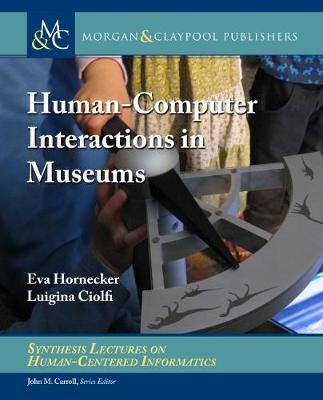
Human-Computer Interactions in Museums
Morgan & Claypool Publishers (Verlag)
978-1-68173-513-9 (ISBN)
Museums have been a domain of study and design intervention for Human-Computer Interaction (HCI) for several decades.
However, while resources providing overviews on the key issues in the scholarship have been produced in the fields of museum and visitor studies, no such resource as yet existed within HCI. This book fills this gap and covers key issues regarding the study and design of HCIs in museums. Through an on-site focus, the book examines how digital interactive technologies impact and shape galleries, exhibitions, and their visitors. It consolidates the body of work in HCI conducted in the heritage field and integrates it with insights from related fields and from digital heritage practice. Processes of HCI design and evaluation approaches for museums are also discussed. This book draws from the authors' extensive knowledge of case studies as well as from their own work to provide examples, reflections, and illustrations of relevant concepts and problems.
This book is designed for students and early career researchers in HCI or Interaction Design, for more seasoned investigators who might approach the museum domain for the first time, and for researchers and practitioners in related fields such as heritage and museum studies or visitor studies. Designers who might wish to understand the HCI perspective on visitor-facing interactive technologies may also find this book useful.
Eva Hornecker is a Professor of Human-Computer Interaction at the Department of Computing in the Faculty of Media at Bauhaus-Universitat Weimar in Germany, with a second affiliation in the Faculty of Arts and Design. She holds a Doctorate (Dr.Ing) from the University of Bremen. Her work focuses on the human interaction angle of novel technologies beyond the desktop computer, in particular on tangible and full-body interaction and the user experience thereof, on social and situated interaction, and on how to design for these. Her work creates a bridge between technology, design, and social sciences. She is an expert on museum technology and the study of visitor interaction with installations, and in her research she has collaborated with museums in Germany, Austria, the UK, and the Netherlands. Eva is a Senior Member of the ACM and co-founded the ACM Conference on Tangible, Embedded, and Embodied Interaction (TEI). Luigina Ciolfi is Professor of Human Centred Computing in the Faculty of Science, Technology and Arts at Sheffield Hallam University (UK). She holds a Ph.D. in Computer Science/Human-Computer Interaction from the University of Limerick. An active researcher and teacher in HCI and CSCW for over two decades in Italy, Ireland, and the UK, Luigina studies and writes about situated interaction, participation in design, and human practices in socio-technical settings. She has extensive experience with digital technologies for heritage, with a track record of projects involving national and European collaborators from academia, industry, and the cultural sector. She is an expert reviewer and advisor on these topics for several public funding bodies. Notable service roles include Associate Editor, CSCW Journal; Conference Chair, ECSCW 2017; Subcommittee Co- Chair, ACM CHI 2018-2019; and Papers Co-Chair, CSCW 2015. Luigina is a Senior Member of the ACM. John M. Carroll is Distinguished Professor of Information Sciences and Technology at Penn State University, and was a founder of human-computer interaction.He served on the program committee of the 1982 Bureau of Standards Conference on the Human Factors of Computing Systems that in effect inaugurated the field and was the direct predecessor of the field's flagship conference series, the ACM CHI Conferences. Through the past two decades, Carroll has been a leader in the development of the field of Human-Computer Interaction. In 1984 he founded the User Interface Institute at the IBM Thomas J.Watson Research Center, the most influential corporate research laboratory during the latter 1980s. In the 1994, he joined Virginia Tech as Department Head of Computer Science where in 1995 he led the effort to form the university's Center for Human-Computer Interaction. That year, Virginia Tech was invited to join the Human-Computer Interaction Consortium, a group of the leading corporate and academic HCI research organizations in the world. He has written more than 250 technical papers, more than 25 conference plenary addresses, and 13 books, including HCI Models, Theories, and Frameworks, and Usability Engineering (with Mary Beth Rosson). He serves on 10 editorial boards for journals and handbooks, and is the current editor-in-chief of ACM Transactions on Computer- Human Interaction (ToCHI). He has won the Rigo Career Achievement Award from ACM (SIGDOC), received the Silver Core Award from IFIP, and is a member of the CHI Academy. In 2003 he became the fifth recipient of the CHI Lifetime Achievement Award, the most prestigious research award in HCI.
Introduction
Acknowledgements
Understanding the Context: Key Themes for Visitor Interaction in Museums
Different Interaction Frames
Visitor Participation and Contributions
The Development Process
Evaluation in Museums
Conclusions
References
Authors' Biographies
| Erscheinungsdatum | 07.05.2019 |
|---|---|
| Reihe/Serie | Synthesis Lectures on Human-Centered Informatics |
| Mitarbeit |
Herausgeber (Serie): John M. Carroll |
| Verlagsort | San Rafael |
| Sprache | englisch |
| Maße | 191 x 235 mm |
| Gewicht | 1 g |
| Themenwelt | Kunst / Musik / Theater |
| Geisteswissenschaften ► Geschichte ► Hilfswissenschaften | |
| Informatik ► Software Entwicklung ► User Interfaces (HCI) | |
| ISBN-10 | 1-68173-513-X / 168173513X |
| ISBN-13 | 978-1-68173-513-9 / 9781681735139 |
| Zustand | Neuware |
| Haben Sie eine Frage zum Produkt? |
aus dem Bereich


